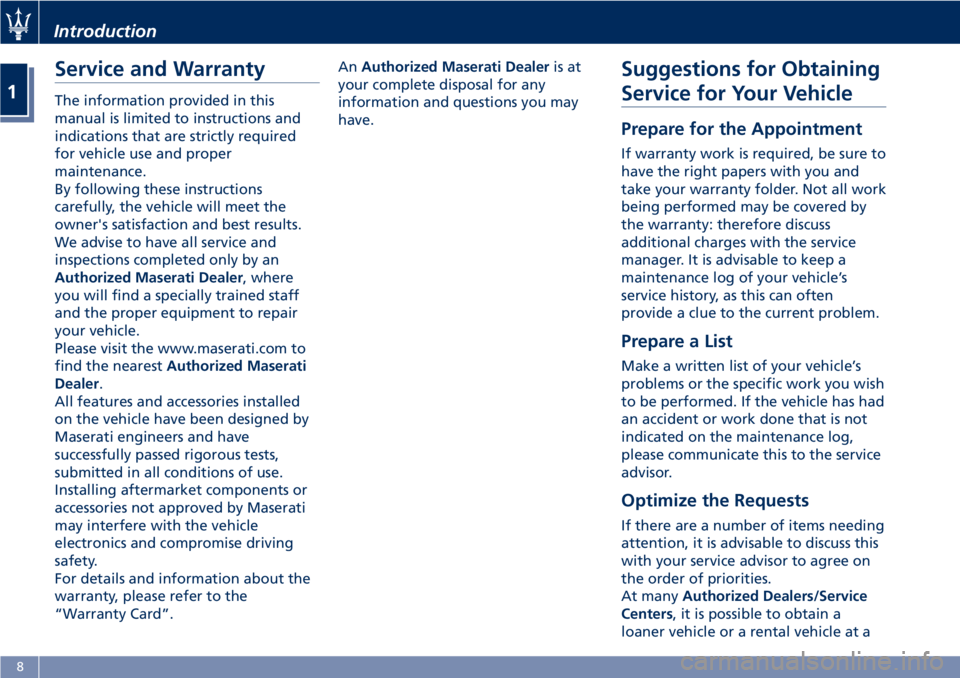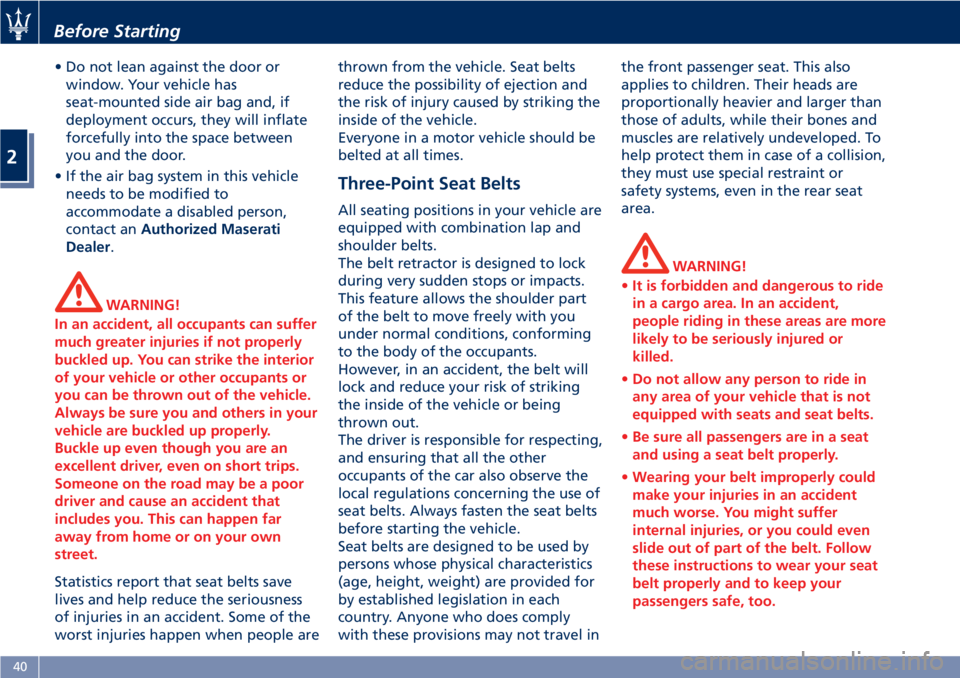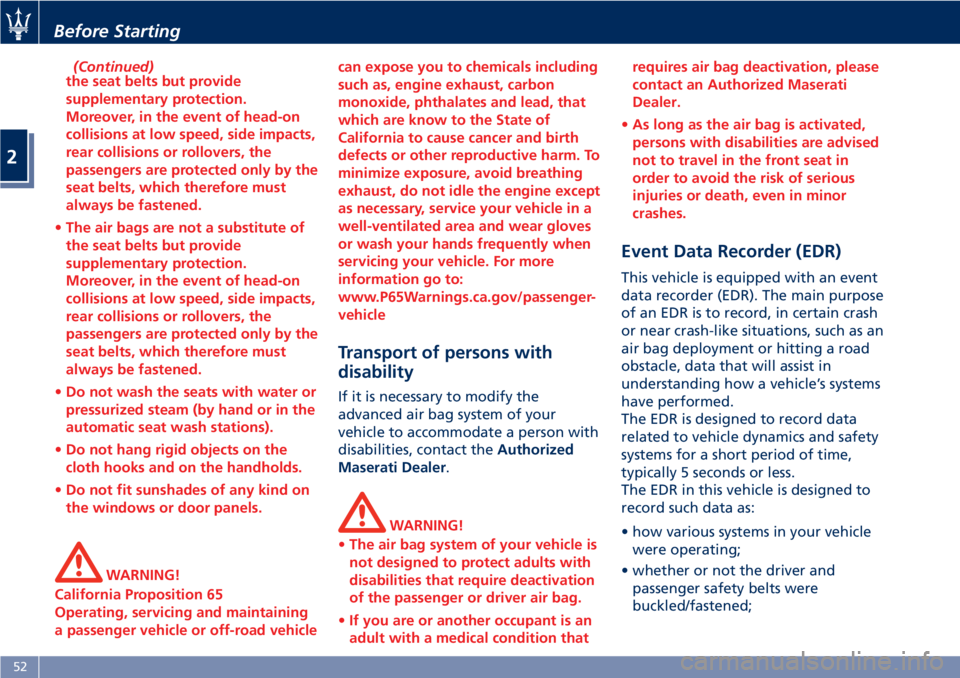2020 MASERATI GRANTURISMO CONVERTIBLE air condition
[x] Cancel search: air conditionPage 11 of 296

Abbreviations
Some descriptions and terms with
particular meanings are found in this
manual in abbreviated form.
A/CAir-Conditioning System.
ABSAnti-Lock Braking System.
ALCAdaptive Light Control.
ALRAutomatic Locking Retractor.
ASRAnti-Slip Regulation.
BOSBrake Override System.
CANController Area Network.
CCCruise Control.
CRSChild Restraint System.
DRLDaytime Running Lights.
EBDElectronic Brake-force
Distribution.
ECUElectronic Control Unit.
EDREvent Data Recorder.
EPBElectric Parking Brake.
ESCElectronic Stability Control.
ETDEmergency Tensioning
Device.
FTPFlash To Pass.
HBAHydraulic Brake Assistance.
ICEIncrease Control and
Efficiency.LATCHLower Anchors and Tether
for CHildren.
MILMalfunction Indicator Light.
MTC+Maserati Touch Control Plus.
OBDOn Board Diagnostics.
ORCOccupant Restraint
Controller.
RHDRight-Hand Drive.
SBRSeat Belt Reminder.
TFTThin Film Transistor.
TPMSTire Pressure Monitoring
System.
VINVehicle Identification
Number.
Updating
Constant improvements are being
performed to maintain this vehicle's
high level of quality. Therefore, there
may be differences between this
manual and your vehicle.
Maserati reserves the right to carry
out design and functional changes
and to provide updates or
improvements.
This Owner's Manual illustrates and
describes all versions of the current
vehicle model. Therefore, some of the
equipment and accessories in this
publication may not appear on your
vehicle; please only consider the
information related to your vehicle.
All specifications and illustrations
contained in this manual are as of the
Manual publishing date.
NOTE:
The updated version of the on-board
documentation can be consulted by
accessing the section “SERVICES” on
the websitewww.maserati.comor by
using the specific apps developed for
the more common Tablet and
Smartphone.
Introduction
1
7
Page 12 of 296

Service and Warranty
The information provided in this
manual is limited to instructions and
indications that are strictly required
for vehicle use and proper
maintenance.
By following these instructions
carefully, the vehicle will meet the
owner's satisfaction and best results.
We advise to have all service and
inspections completed only by an
Authorized Maserati Dealer, where
you will find a specially trained staff
and the proper equipment to repair
your vehicle.
Please visit the www.maserati.com to
find the nearestAuthorized Maserati
Dealer.
All features and accessories installed
on the vehicle have been designed by
Maserati engineers and have
successfully passed rigorous tests,
submitted in all conditions of use.
Installing aftermarket components or
accessories not approved by Maserati
may interfere with the vehicle
electronics and compromise driving
safety.
For details and information about the
warranty, please refer to the
“Warranty Card”.AnAuthorized Maserati Dealeris at
your complete disposal for any
information and questions you may
have.
Suggestions for Obtaining
Service for Your Vehicle
Prepare for the Appointment
If warranty work is required, be sure to
have the right papers with you and
take your warranty folder. Not all work
being performed may be covered by
the warranty: therefore discuss
additional charges with the service
manager. It is advisable to keep a
maintenance log of your vehicle’s
service history, as this can often
provide a clue to the current problem.
Prepare a List
Make a written list of your vehicle’s
problems or the specific work you wish
to be performed. If the vehicle has had
an accident or work done that is not
indicated on the maintenance log,
please communicate this to the service
advisor.
Optimize the Requests
If there are a number of items needing
attention, it is advisable to discuss this
with your service advisor to agree on
the order of priorities.
At manyAuthorized Dealers/Service
Centers, it is possible to obtain a
loaner vehicle or a rental vehicle at a
Introduction
1
8
Page 16 of 296

Towing the Vehicle
The vehicle has not been designed,
developed and homologated to be
used as a towing vehicle for other
means (e.g. trailers, campers, etc.).
Symbols
There are specific colored plates on or
near some of the components on your
Maserati designed to attract user’s
attention. The related symbols are
important warnings that the user must
follow when using the component
involved.
All symbols reported on the plate and
inside the vehicle, as well as the
component for which the symbols
stand, are summarized in the
following list. These symbols are
divided into categories according to
their meaning.
Danger Symbols
Battery
Corrosive liquid.
Battery
Explosion.
Blower
May start automatically
even with engine off.
Coolant expansion
reservoir
Do not open cap with
engine warm.
Coil - headlights
High voltage.
Belts and pulleys
Moving parts, keep body
and clothing clear.
Air-conditioning lines
High pressure gas, do not
open.
Symbols of Prohibitions and
Compulsory Measures
Battery
Keep away from flames.
Battery
Keep out of children’s
reach.
Heat guards - belts -
pulleys - fans
Do not touch.
Battery
Wear eye protection.
Battery - jack
Refer to the owner manual.
Introduction
1
12
Page 33 of 296

ENVIRONMENTAL!
Batteries contain dangerous materials
that could harm the environment.
Please dispose of them according to
local regulations or at an Authorized
Maserati Dealer.
WARNING!
California Proposition 65
Operating, servicing and maintaining
a passenger vehicle or off-road vehicle
can expose you to chemicals including
such as, engine exhaust, carbon
monoxide, phthalates and lead, that
which are know to the State of
California to cause cancer and birth
defects or other reproductive harm. To
minimize exposure, avoid breathing
exhaust, do not idle the engine exceptas necessary, service your vehicle in a
well-ventilated area and wear gloves
or wash your hands frequently when
servicing your vehicle. For more
information go to:
www.P65Warnings.ca.gov/passenger-
vehicle
NOTE:
Avoid touching the new battery with
your fingers. Skin oils may cause
battery deterioration. If you touch a
battery, clean with alcohol.
• Fit a new battery of the same type,
observing the indicated polarity:
match the "+" sign on the battery to
the "+" sign on the inside of the
battery holder.
• Fit the battery holder into the radio
control case and secure it by
tightening the retaining screw.
Radio Frequency Transmitter -
General Information
Some countries do not require a
specific domestic homologation in the
event that the vehicle has already
obtained other European
homologations.The homologation number (EEC
regulations) of the radio control
device is indicated in the picture.
The current device feature is subject to
following conditions:
• This device may not cause harmful
interference.
• This device must accept any
interference received, including
interference that may cause
undesired operation.
If your transmitter device fails to
operate from a normal distance, check
for these two conditions:
• A weak battery in the transmitter
device. The expected life of the
battery in normal use is a minimum
of three years.
• Closeness to a radio transmitter such
as a radio station tower, airport
Before Starting
2
29
Page 40 of 296

Two gas struts facilitate the lid
opening. The struts are calibrated to
ensure they function correctly with the
weights specified by the manufacturer.
The arbitrary addition of objects
(spoiler, luggage rack etc.) may impair
the lid’s correct operation and safety.
WARNING!
When using the trunk compartment,
never exceed the maximum loads
allowed (see “Technical Data" in
section "Features and Specifications”).
Also check that the objects contained
in the luggage compartment are
arranged properly.
The trunk compartment is illuminated
by a light that comes on automatically
when the lid is opened; switching off is
timed.
If the trunk compartment lid is left
open, the light switches off after a few
minutes. To turn it on again, close the
lid and then reopen it.
NOTE:
The soft top automatic movement is
disabled when the trunk compartment
is open.
Closing
To close the trunk lid grasp one of the
handles as indicated on the inner
covering and lower the lid.
Then press gently on the outside of
the lid, in correspondence of the lock,
until hearing it click in place.
Emergency Opening
If necessary, the trunk compartment lid
can be opened by pulling the small
cable, located underneath the left rear
seat.Once you have located the cable and
pulled it out from the seat, pull it
forward to open the trunk
compartment lid.
Independent Trunk Lid
Unlocking
To allow the user to hold only the
trunk lid unlocked compared to the
doors condition, there is a dedicated
feature which can be activated by
MTC+ in “Doors & Locks” menu (see
"MTC+ Settings" in section
"Dashboard Instruments and
Controls".
Before Starting
2
36
Page 42 of 296

Lift the hood completely: this
operation is facilitated by two gas
struts keeping the fully open position.
With the key in the ignition switch in
MAR (ON)position, the specific red
warning light will display on the
instrument cluster with the message
indicating that the hood is open (see
chapter “Instrument Cluster” in section
“Dashboard Instrument and
Controls”).
Closing
Lower the hood to about 20 cm (8 in)
from the contact area of the engine
compartment and then drop it. This
should secure the inclusion of the
latch.
CAUTION!
To prevent possible damage, do not
slam the hood to close it.
WARNING!
•Be sure the hood is fully latched
before driving your vehicle. If the lid
is not fully latched, it could open
when the vehicle is in motion and
block your vision. Failure to follow
this warning could result in serious
injury or death.
•Gear shifting is always active and
may be performed even when one
or more doors, the hood or the trunk
lid are open. Therefore, in these
conditions, take great care to avoid
moving the transmission shift lever
and so accidentally engage gears.
Occupants Restraint
Systems
The listed occupants restraint systems
are some of the most important safety
features in your vehicle:
• Three-point seat belts (also called lap
and shoulder belts) for the driver and
all passengers.
• Front air bags for driver and
passenger.
• Seat-mounted side air bags for the
driver and front passenger.
• An energy-absorbing steering
column and steering wheel.
• Front seat belts incorporate a
pretensioner (Emergency Tensioning
Device - ETD) that may enhance
occupant protection by managing
the energy created during an impact.
• Front seat belt retractors are
equipped with load limiting devices
which control the seat belt reeling
out so as to adjust the force exerted
on the shoulders while the seat belt
is in restraining mode.
• All seat belts system (except the
driver’s) include Automatic Locking
Retractors (ALR), which lock the seat
belt webbing into position by
extending the belt all the way out
Before Starting
2
38
Page 44 of 296

• Do not lean against the door or
window. Your vehicle has
seat-mounted side air bag and, if
deployment occurs, they will inflate
forcefully into the space between
you and the door.
• If the air bag system in this vehicle
needs to be modified to
accommodate a disabled person,
contact anAuthorized Maserati
Dealer.
WARNING!
In an accident, all occupants can suffer
much greater injuries if not properly
buckled up. You can strike the interior
of your vehicle or other occupants or
you can be thrown out of the vehicle.
Always be sure you and others in your
vehicle are buckled up properly.
Buckle up even though you are an
excellent driver, even on short trips.
Someone on the road may be a poor
driver and cause an accident that
includes you. This can happen far
away from home or on your own
street.
Statistics report that seat belts save
lives and help reduce the seriousness
of injuries in an accident. Some of the
worst injuries happen when people arethrown from the vehicle. Seat belts
reduce the possibility of ejection and
the risk of injury caused by striking the
inside of the vehicle.
Everyone in a motor vehicle should be
belted at all times.
Three-Point Seat Belts
All seating positions in your vehicle are
equipped with combination lap and
shoulder belts.
The belt retractor is designed to lock
during very sudden stops or impacts.
This feature allows the shoulder part
of the belt to move freely with you
under normal conditions, conforming
to the body of the occupants.
However, in an accident, the belt will
lock and reduce your risk of striking
the inside of the vehicle or being
thrown out.
The driver is responsible for respecting,
and ensuring that all the other
occupants of the car also observe the
local regulations concerning the use of
seat belts. Always fasten the seat belts
before starting the vehicle.
Seat belts are designed to be used by
persons whose physical characteristics
(age, height, weight) are provided for
by established legislation in each
country. Anyone who does comply
with these provisions may not travel inthe front passenger seat. This also
applies to children. Their heads are
proportionally heavier and larger than
those of adults, while their bones and
muscles are relatively undeveloped. To
help protect them in case of a collision,
they must use special restraint or
safety systems, even in the rear seat
area.
WARNING!
•It is forbidden and dangerous to ride
in a cargo area. In an accident,
people riding in these areas are more
likely to be seriously injured or
killed.
•Do not allow any person to ride in
any area of your vehicle that is not
equipped with seats and seat belts.
•Be sure all passengers are in a seat
and using a seat belt properly.
•Wearing your belt improperly could
make your injuries in an accident
much worse. You might suffer
internal injuries, or you could even
slide out of part of the belt. Follow
these instructions to wear your seat
belt properly and to keep your
passengers safe, too.
Before Starting
2
40
Page 56 of 296

(Continued)
the seat belts but provide
supplementary protection.
Moreover, in the event of head-on
collisions at low speed, side impacts,
rear collisions or rollovers, the
passengers are protected only by the
seat belts, which therefore must
always be fastened.
•The air bags are not a substitute of
the seat belts but provide
supplementary protection.
Moreover, in the event of head-on
collisions at low speed, side impacts,
rear collisions or rollovers, the
passengers are protected only by the
seat belts, which therefore must
always be fastened.
•Do not wash the seats with water or
pressurized steam (by hand or in the
automatic seat wash stations).
•Do not hang rigid objects on the
cloth hooks and on the handholds.
•Do not fit sunshades of any kind on
the windows or door panels.
WARNING!
California Proposition 65
Operating, servicing and maintaining
a passenger vehicle or off-road vehiclecan expose you to chemicals including
such as, engine exhaust, carbon
monoxide, phthalates and lead, that
which are know to the State of
California to cause cancer and birth
defects or other reproductive harm. To
minimize exposure, avoid breathing
exhaust, do not idle the engine except
as necessary, service your vehicle in a
well-ventilated area and wear gloves
or wash your hands frequently when
servicing your vehicle. For more
information go to:
www.P65Warnings.ca.gov/passenger-
vehicle
Transport of persons with
disability
If it is necessary to modify the
advanced air bag system of your
vehicle to accommodate a person with
disabilities, contact theAuthorized
Maserati Dealer.
WARNING!
•The air bag system of your vehicle is
not designed to protect adults with
disabilities that require deactivation
of the passenger or driver air bag.
•If you are or another occupant is an
adult with a medical condition thatrequires air bag deactivation, please
contact an Authorized Maserati
Dealer.
•As long as the air bag is activated,
persons with disabilities are advised
not to travel in the front seat in
order to avoid the risk of serious
injuries or death, even in minor
crashes.
Event Data Recorder (EDR)
This vehicle is equipped with an event
data recorder (EDR). The main purpose
of an EDR is to record, in certain crash
or near crash-like situations, such as an
air bag deployment or hitting a road
obstacle, data that will assist in
understanding how a vehicle’s systems
have performed.
The EDR is designed to record data
related to vehicle dynamics and safety
systems for a short period of time,
typically 5 seconds or less.
The EDR in this vehicle is designed to
record such data as:
• how various systems in your vehicle
were operating;
• whether or not the driver and
passenger safety belts were
buckled/fastened;
Before Starting
2
52